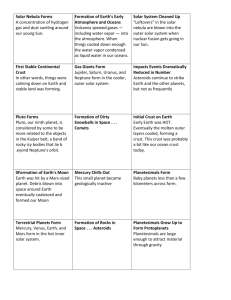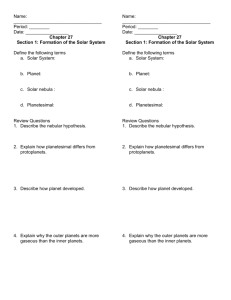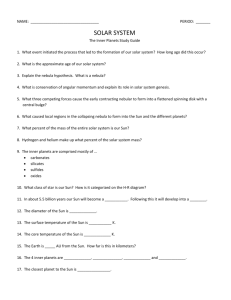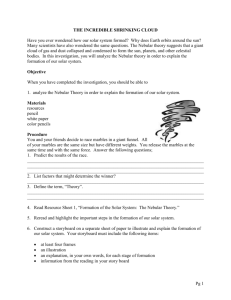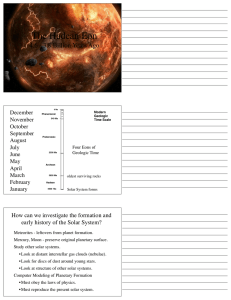Test #1 Study Questions
advertisement
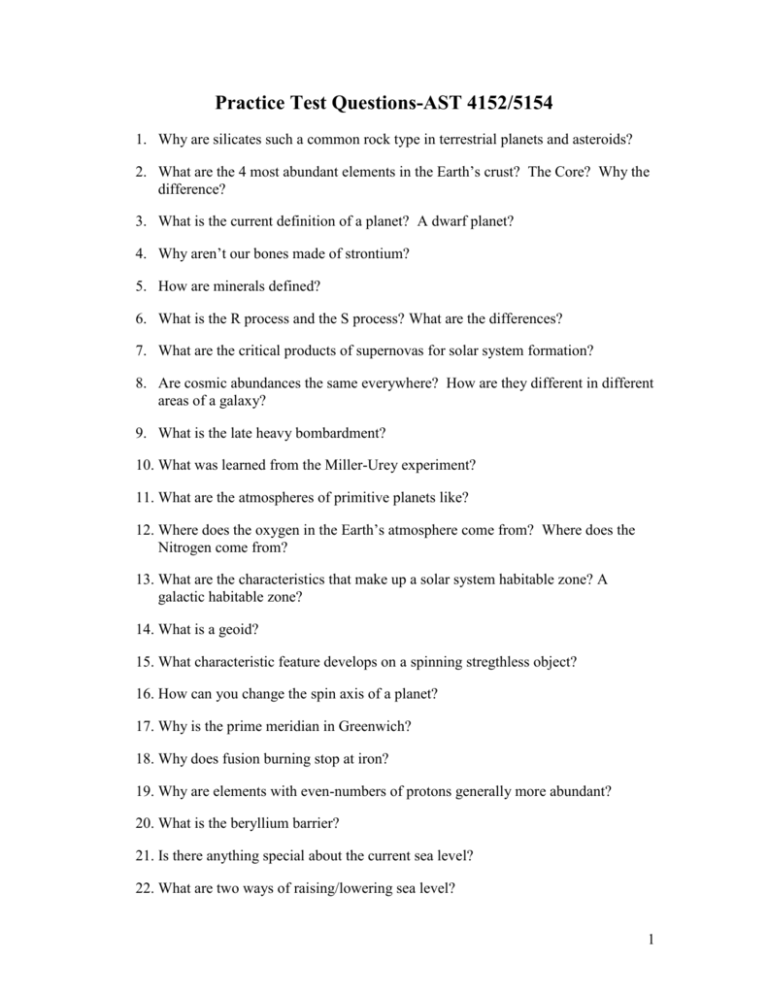
Practice Test Questions-AST 4152/5154 1. Why are silicates such a common rock type in terrestrial planets and asteroids? 2. What are the 4 most abundant elements in the Earth’s crust? The Core? Why the difference? 3. What is the current definition of a planet? A dwarf planet? 4. Why aren’t our bones made of strontium? 5. How are minerals defined? 6. What is the R process and the S process? What are the differences? 7. What are the critical products of supernovas for solar system formation? 8. Are cosmic abundances the same everywhere? How are they different in different areas of a galaxy? 9. What is the late heavy bombardment? 10. What was learned from the Miller-Urey experiment? 11. What are the atmospheres of primitive planets like? 12. Where does the oxygen in the Earth’s atmosphere come from? Where does the Nitrogen come from? 13. What are the characteristics that make up a solar system habitable zone? A galactic habitable zone? 14. What is a geoid? 15. What characteristic feature develops on a spinning stregthless object? 16. How can you change the spin axis of a planet? 17. Why is the prime meridian in Greenwich? 18. Why does fusion burning stop at iron? 19. Why are elements with even-numbers of protons generally more abundant? 20. What is the beryllium barrier? 21. Is there anything special about the current sea level? 22. What are two ways of raising/lowering sea level? 1 23. How does a spinning solar nebula relate to the orbital motions of the solar system? 24. What is the solar system’s angular momentum problem? 25. Where is the Oort cloud? 26. What is the effect of water and pressure on the melting temperature of rock? 27. Assume the Earth is 30% by mass iron. How much heat is released during core formation? 28. How do magnetic reversals show up in sea-floor spreading? The Earth’s magnetic field reverses about how often? 29. Look at the distribution of craters on Earth. What does that say about the relative ages of the continents? 30. Know how to calculate mass and volume fractions. For example: The density of Mars is 3.95 g/cm3. What is the mass fraction of the core? Assume silicates are 3 g/cm3 and iron is 8 g/cm3. How is this different from the Earth’s? 31. Where are most earthquakes and volcanoes on Earth and why? Why don’t we get Earthquakes in Florida? 32. Know how to calculate crustal thickness. 33. How does continental crust accumulate on Earth? 34. Are continents rifting apart now? 35. Discuss the process of hot-spot volcanism and how that relates to the construction of Olympus Mons. 36. What is Bode’s law? 37. Is there any room for more terrestrial planets in the inner solar system? Why? 38. Why isn’t there a planet between Jupiter and Mars? 39. What evidence is there for more terrestrial planets during the early days of the solar system? 40. What do massive stars in our protoplanetary nebula do to effect the formation of our solar system? 41. If the Sun was born in a dense cluster of stars, why don’t we see them nearby now? 2 42. What was the Hadean period like on Earth? 43. What was the role of 26Al and 60Fe in heating the early Earth? 44. How do we know the age of the solar system? 45. What is a solid solution? A polymorph? 46. How do conditions on Earth affect the evolution of minerals? 47. What happened during the “Red Earth” period? 48. What is postperovskite, where is it found, why is it important, how does it effect the magnetic field? 49. Why did Lord Kelvin get the age of the Earth wrong? What was Perry’s idea? 50. What are hotspots? 51. How is continental crust generated? 52. What are granites and how are they different from basalts and rhyolites? 53. What is stress? Strain? 54. What is Hooke’s Law? Jeffreys’ Theorem? 55. What is the angle of repose? 56. Can the coefficient of friction vary with temperature? 57. How can you increase the strength of rocks? 58. What is the difference between a scientific law and a theory? 59. The strength of planetary crusts depends on…..? 60. The crust responds to a load by what? And over what time scale? 61. The horizontal scale of crustal warping is? 62. Was Holland always below sea level? 63. What are the major heat sources for the Earth? 3
